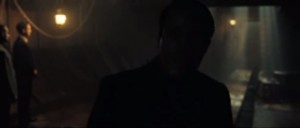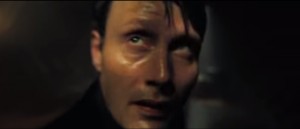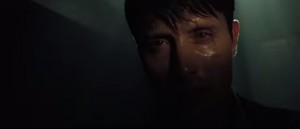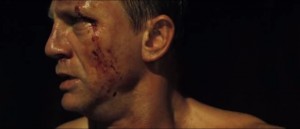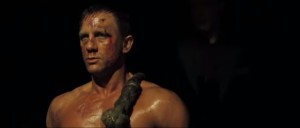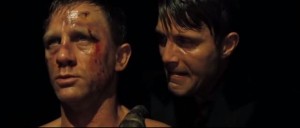As part of my research into refining my interrogation room scene, I have been looking at similar scenes to hopefully gain some inspiration or new ideas on which elements I would like to use for my own scene. Studying only the visuals and not listening to the audio has helped me to better understand which elements I would like to include in my own version of an interrogation scene.
The interrogation room scene in ‘Casino Royale’ implements similar lighting to what I would like to use. The set is quite dark with a hard light source lighting the victim (Bond) creating strong shadows and highlighting the features of both characters’ faces as they move in and out of the path of the light source. The camera moves quite a lot within this scene, drawing the audience’s attention to different movements, characters and items which create suspense and a sense of imminent danger, putting the audience on the edge of their seat. The framing choices make use of the background, middle ground and foreground of the shot, connecting all of the things happening in each part of the frame with one another.
<iframe width=”560″ height=”315″ src=”https://www.youtube.com/embed/JDJOXiPSRIs” frameborder=”0″ allowfullscreen></iframe>
The camera pans quickly up and down, to show the switchblade and the chair. The fast movement creates a sense of panic for the audience as their focus is guided between the two items and then to Bond in the background lying on the ground.
Another interesting shot I found was the captor moving towards the camera from complete darkness into the path of the light, creating a sense of uneasiness as well as demonstrating that he is the person to fear in this scene.
The challenge of creating a scene with very limited lighting to create an almost pitch black setting that will still allow the camera to operate and function well is something I am facing. The lighting used in this scene is something I want to try and experiment with and create for my own scene. In this particular shot, the light source seems to be coming from the upper left of frame, positioned slightly down to illuminate only a small part of the character’s face as he moves towards the camera. It seems as though Paul’s rule of positioning the light source where the interviewer would be in comparison to the actor/subject and camera is being implemented here. The light source is direct and hard, creating strong shadows and narrowing the illumination to only light a small portion of the character’s face. Perhaps a red hat with barn doors was used in this case to create the narrow, hard lighting.
The lighting implemented in another shot of the captor is also quite interesting and something I would like to try to replicate for my own scene.
The shadows across his face make it clear that he is dangerous. The light source is quite bright on his left ear and the right side of his face is mostly shadowed, suggesting that the light source is slightly behind him to the upper right of frame, positioned down onto him. Once again, the lighting is hard, direct, and narrow. I would like to try and experiment with all of these lighting choices, trying to replicate them myself, taking almost identical stills of my tests to see if my first thoughts are right, or whether different lighting positions have been used in this scene.
The next shot shows the victim illuminated, while the rest of the room is dark – another thing I want to use for my own scene. The hard lighting over his whole body makes him seem quite vulnerable, almost like a deer in headlights.
The only way I can think that this effect could be achieved is by having a direct overhead light, illuminating the actor while ensuring the surrounds are dark. However, when he turns his head to his left, shadows appear around his jawline. This suggests that the offside of his face is being lit and that the light source is positioned to the left of frame, close to the camera position.
In terms of framing, I hadn’t previously considered using a shot of the victim where the side of his face is facing the camera and had only thought of more face-one shots. I’m not sure whether I like this frame, however it might be useful to show the victim moving his head around more vigorously and looking at his surroundings.
This perspective shot is quite simple, but effective in demonstrating that there is no escape. This is something I struggled to show in my sketch of this scene as the location only permitted me to shoot in one direction. The set dressing is really dynamic and I definitely want to include multiple perspective shots to demonstrate the victim trying to plan his escape, and the doomed feeling of the reality that he can’t. Location depends on this kind of shot to work and I need to think more creatively of ways I can create something as dynamic as this shot.
The movement of the camera as the captor approaches the victim in the chair is something I am interested in experimenting with as well. The camera tilt down from the captor’s face to his hand holding the rope/weapon and pans from right to left to reveal him walking towards Bond who is at a 90 degree angle to the camera. This is an interesting alternative to the shot I used of the captor walking into frame as the camera remained static. I would like to try this kind of movement in my next sketch of this scene. I would never have considered positioning the victim at a 90 degree angle to the camera as the captor walks towards him as I was always aware of trying to show his reaction to being in his dire situation. For this reason, I won’t be positioning the actor in this way.
The next shot really interests me and is something I immediately envisioned when I wrote the scene.
The captor is in complete darkness behind the victim who is illuminated. The offside of his face is lit, with shadows on the onside of his face, suggesting that the light source is positioned at a sharp angle down from the top left of frame so that the captor is not lit until he moves forward into the light.
The camera tracks in as the captor moves into the light. While the movement is quite dramatic, it’s not something I would necessarily want to replicate as my scene is more about the terrifying experience the victim is going through rather than the pain the captor is about to inflict. I want my scene to be more ambiguous than the actions in this scene.
The majority of the rest of the shots in the rest of this scene include a wide shot and many close ups in a shot-reverse shot style between the two characters – something I am not interested in replicating. Overall, this scene provided me with ideas mainly to do with lighting and set dressing which I will be experimenting with in future sketch shoots.
